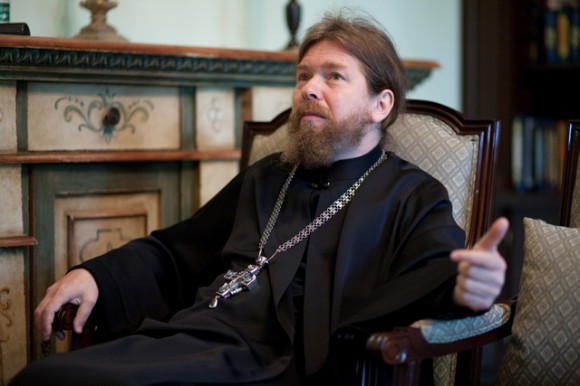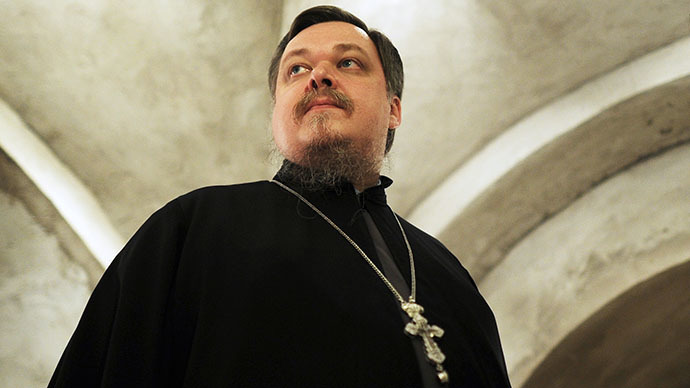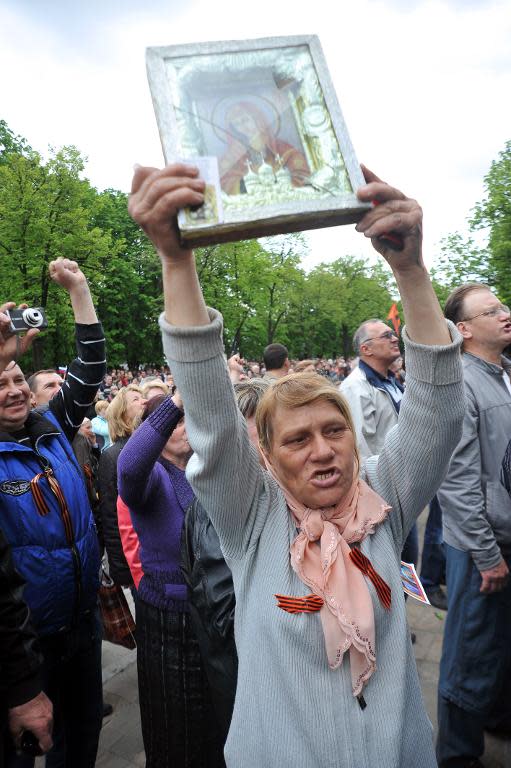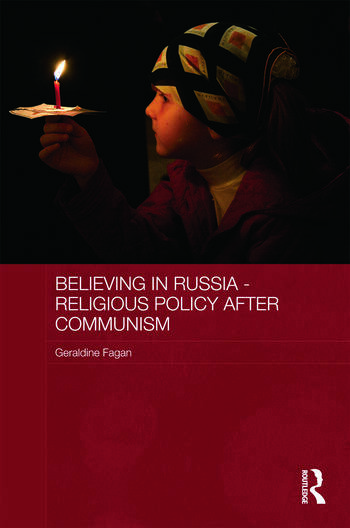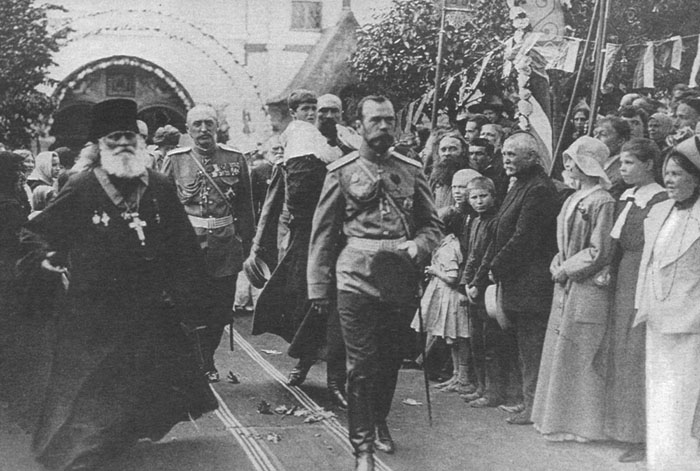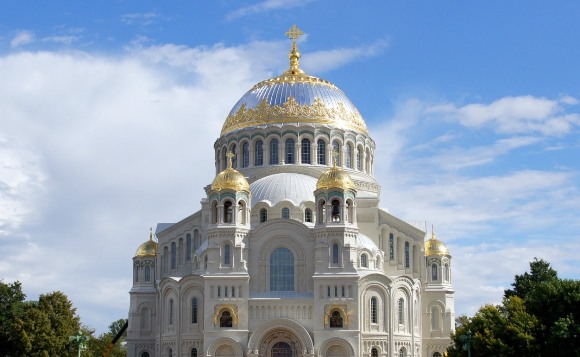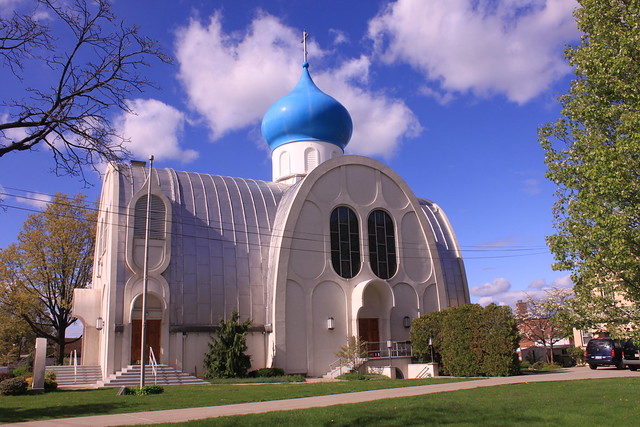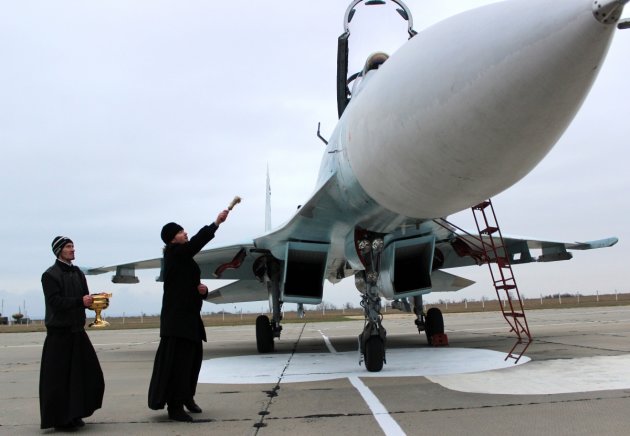The Russian orthodox church has always been a powertool in the hands of the Russian authorities in Moscow. Both the Czars used the church and the Sovjet authorities too. Stalin used the Orthodox church to create Russian Patriotism during the Second World War, called "The Great Patriotic War" in the SovjetUnion and the Russian Federation. Today Putin uses Russian Orthodoxy to create a climate of Russian Nationalism and an ethnic Russian identity for his political causes. His regime and maintainance of power and in his conflict with Ukraine, and in the New Cold War with the West (Europe and the USA).
 History of the Russian Orthodox Church
History of the Russian Orthodox Church The Trinity Cathedral of Troitse-Sergieva Lavra
The Trinity Cathedral of Troitse-Sergieva LavraThe Russian Orthodox Church (Russian: Русская Православная Церковь) is traditionally said to have been founded by the Apostle Andrew, who is thought to have visited Scythia and Greek colonies along the northern coast of the Black Sea. According to one of the legends, St. Andrew reached the future location of Kiev and foretold the foundation of a great Christian city. The spot where he reportedly erected a cross is now marked by St. Andrew's Cathedral.
Christianization of the Rus'Constantinople's greatest mission outreach was to areas known as Kievan Rus that later became the states of Ukraine, Belarus, and Russia. Christianity was introduced into Kievan Rus by Greek missionaries from Byzantium in the 9th century. In 863–869, Saint Cyril and Saint Methodius translated parts of the Bible into Old Church Slavonic language for the first time, paving the way for the Christianization of the Slavs. There is evidence that the first Christian bishop was sent to Novgorod from Constantinople either by Patriarch Photius or Patriarch Ignatios, circa 866-867 AD.
By the mid-10th century, there was already a Christian community among Kievan nobility, under the leadership of Greek and Byzantine priests, although paganism remained the dominant religion. Princess Olga of Kiev was the first ruler of Kievan Rus to convert to Christianity, either in 945 or 957. Undoubtedly influenced by his Christian grandmother and by a proposed marriage alliance with the Byzantine imperial family, Olga's grandson Vladimir I (c. 956-1015) prince of Kiev, from among several options, chose the Byzantine rite. Baptized in 988, he led the Kievans to Christianity. This date is often considered the official birthday of the Russian Orthodox Church. Thus, in 1988, the Church celebrated its millennial anniversary.
 15th century
15th centuryDuring the 15th century the Russian Church was pivotal in the survival and life of the Russian state. Such holy figures as Sergius of Radonezh and Metropolitan Alexis helped the country to withstand years of Tatar oppression, and to expand both economically and spiritually.
At the Council of Florence 1439, a group of Roman Catholic and Eastern Orthodox Church leaders agreed upon terms of reunification of the two branches of Christianity. The Russian Prince Basil II of Moscow, however, rejected the concessions to the Catholic Church and forbade the proclamation of the acts of the Council in Russia in 1452, after a short-lived East-West reunion. Metropolitan Isidore was in the same year expelled from his position as an apostate.
In 1448, the Russian Church became independent from the Patriarchate of Constantinople when the Russian bishops elected their own patriarch, Metropolitan Jonas, without recourse to Constantinople, and the Russian church was thenceforth autocephalous.
 Russian Orthodox Cathedral of St Nicholas in Nice. (I have visited it. It was a wonderful, rich and beautiful decorated church)
Russian Orthodox Cathedral of St Nicholas in Nice. (I have visited it. It was a wonderful, rich and beautiful decorated church)Metropolitan Jonas was given the title of Metropolitan of Moscow and All Rus'. He also received the fifth rank in honour after the patriarchs of Constantinople, Alexandria, Antioch, and Jerusalem. Five years later, Constantinople fell to the Ottoman Turks. From this point onward the Russian Orthodox Church saw Moscow as the Third Rome, legitimate successor to Constantinople, and the Patriarch of Moscow as head of the Russian Orthodox Church.
 Tsar Alexis praying before the relics of Metropolitan Philip17th century
Tsar Alexis praying before the relics of Metropolitan Philip17th centuryThe beginning of the 17th century proved to be a hard time for Russia. The Poles and Swedes invaded Russia from the west. At this time of trouble the Russian Church fulfilled its patriotic duty before the people with honor, as it did before. Patriarch Germogen (1606–1612), the leader of an insurrection against invading Poles, and later starved to death imprisoned, was the spiritual leaders of the mass levy led by Minin and Pozharsky. The defense during the siege of Trinity-St. Sergius Lavra from a Polish-Lithuanian irregular army between 1608 and 1610 has been inscribed forever in the chronicle of the Russian state and the Russian Church.
 Patriarch Germogen (1606–1612), the leader of an insurrection against invading PolesExpansion
Patriarch Germogen (1606–1612), the leader of an insurrection against invading PolesExpansionIn the late 17th and early 18th centuries, the Russian Orthodox Church experienced phenomenal geographic expansion. In 1684, Moscow Patriarchate requested Constantinople that the Metropolia of Kiev be made subordinate to Moscow but the request was declined. Eventually, in 1686 after patriarch Parthenius IV was succeeded by Dionysius IV it was agreed to subordinate the Metropolia of Kiev to Moscow. But just a year later in 1687 such subordination was denounced by the Ecumenical Patriarchate of Constantinople and those in charge were defrocked because of the bribe.
In any case this brought millions of faithful and a half dozen dioceses under the pastoral and administrative care of the Russian Orthodox Patriarch. In the following two centuries, missionary efforts stretched out across Siberia into Alaska, then into the United States at California. Eminent people on that missionary effort included St. Innocent of Irkutsk, St.Herman of Alaska, St. Innocent of Siberia and Alaska. They learned local languages and translated the gospels and the hymns. Sometimes those translations required the invention of new systems of transcription.
 Russian revolution
Russian revolutionIn 1914 in Russia, there were 55,173 Russian Orthodox churches and 29,593 chapels, 112,629 priests and deacons, 550 monasteries and 475 convents with a total of 95,259 monks and nuns.
 Holy Sobor of 1917, following the election of Saint Tikhon as Patriarch of Moscow
Holy Sobor of 1917, following the election of Saint Tikhon as Patriarch of Moscow Newly elected Patriarch Tikhon presides at “All-Russian” Church Council in Moscow, 1917.
Newly elected Patriarch Tikhon presides at “All-Russian” Church Council in Moscow, 1917.The year 1917 was a major turning point for the history of Russia, and also the Russian Orthodox Church. The Russian empire was dissolved and the Tsarist government - which had granted the Church numerous privileges – was overthrown. After a few months of political turmoil, the Bolsheviks took power in October 1917 and declared a separation of church and state. The government seized all church lands. Thus the Russian Orthodox Church found itself without official state backing for the first time in its history. One of the first decrees of the new Communist government (issued in January 1918) declared freedom of "
religious and anti-religious propaganda".
This led to a marked decline in the power and influence of the Church. The Church was also caught in the crossfire of
the Russian Civil War that began later the same year, and many leaders of the Church supported what would ultimately turn out to be the losing side (
the White movement).
The Russian Orthodox Church supported the White Army in the Russian Civil War (see White movement) after the October Revolution. This may have further strengthened the Bolshevik animus against the church. According to Lenin, a communist regime cannot remain neutral on the question of religion but must show itself to be merciless towards it. There was no place for the church in Lenin's classless society.
Even before the end of the civil war and the establishment of the Soviet Union, the Russian Orthodox Church came under persecution of the Communist government. The Soviet government stood on a platform of militant atheism, viewing the church as a "counter-revolutionary" organization and an independent voice with a great influence in society. While the Soviet Union officially claimed religious toleration, in practice the government discouraged organized religion and did everything possible to remove religious influence from Soviet society.
The Russian Orthodox Church supported tsarist Russia, therefore creating another reason the Bolsheviks would attempt to diminish their influence on the Russian people and government.
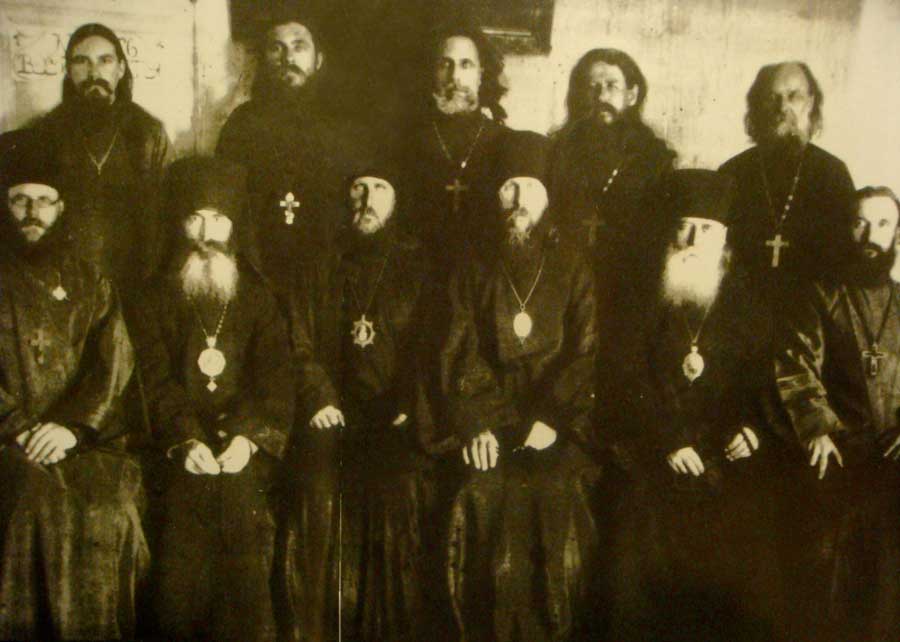 Priests, archbishops and a metropolitan imprisoned in the Solovetsky labor camp (1926). Solovetsky, a thriving monastery before the Bolshevik revolution, was returned to the Russian Church in 1990. Photo source: Tomasz KiznyAnti-religious campaign and persecution in the 1920s and 1930s
Priests, archbishops and a metropolitan imprisoned in the Solovetsky labor camp (1926). Solovetsky, a thriving monastery before the Bolshevik revolution, was returned to the Russian Church in 1990. Photo source: Tomasz KiznyAnti-religious campaign and persecution in the 1920s and 1930sThe main target of the anti-religious campaign in
the 1920s and
1930s was
the Russian Orthodox Church, which had the largest number of faithful. Nearly all of its clergy, and many of its believers, were shot or sent to labor camps. Theological schools were closed, and church publications were prohibited.
The sixth sector of the
OGPU, led by
Yevgeny Tuchkov, began aggressively arresting and executing bishops, priests, and devout worshippers, such as Metropolitan Veniamin in Petrograd in 1922 for refusing to accede to the demand to hand in church valuables (including sacred relics). Some 20,000 people executed just outside Butovo a good percentage of which were Orthodox clergy, ascetics and laymen.
 Yevgeny Aleksandrovich Tuchkov (1892 - 1957), head of the sixth sector of the Joint State Political Directorate (OGPU; the secret police of the Soviet Union from 1922 to 1934), was responsible for the death of many Russian Orthodox bishops, priests, and devout worshippers
Yevgeny Aleksandrovich Tuchkov (1892 - 1957), head of the sixth sector of the Joint State Political Directorate (OGPU; the secret police of the Soviet Union from 1922 to 1934), was responsible for the death of many Russian Orthodox bishops, priests, and devout worshippers After 1928 a mass closure of churches continued until 1939, by which time there was only a few hundred left. According to the official data of the government Commission on Rehabilitation: in 1937 136,900 Orthodox clerics were arrested, 85,300 of them were shot dead; in 1938 28,300 arrested, 21,500 of them shot dead; in 1939 1,500 arrested, 900 of them shot dead; in 1940 5,100 arrested, 1,100 of them shot dead.
 Demolition of the Cathedral of Christ the Saviour in Moscow, December 5, 1931
Demolition of the Cathedral of Christ the Saviour in Moscow, December 5, 1931The Solovki Special Purpose Camp was established in the monastery on the Solovetsky Islands in the White Sea. Eight metropolitans, twenty archbishops, and forty-seven bishops of the Orthodox Church died there, along with tens of thousands of the laity. Of these, 95,000 were put to death, executed by firing squad.[citation needed] Father Pavel Florensky was one of the New-martyrs of this particular period as well as Metropolitan Joseph (Ivan Petrovykh).
Many thousands of victims of persecution were subsequently recognized in a special canon of saints known as the "new-martyrs and confessors of Russia".
World War II rapprochementAfter Nazi Germany's attack on the Soviet Union in 1941, Joseph Stalin revived the Russian Orthodox Church to intensify patriotic support for the war effort. On September 4, 1943, Metropolitans Sergius (Stragorodsky), Alexius (Simansky) and Nicholas (Yarushevich) were officially received by Soviet leader Joseph Stalin. They received a permission to convene a council on September 8, 1943, that elected Sergius Patriarch of Moscow and all Rus'. A new patriarch was elected, theological schools were opened, and thousands of churches began to function. The Moscow Theological Academy and Seminary, which had been closed since 1918, was re-opened.
GlasnostThen, beginning in the late 1980s, under Mikhail Gorbachev, the new political and social freedoms resulted in many church buildings being returned to the church, to be restored by local parishioners. A pivotal point in the history of the Russian Orthodox Church came in 1988 with the 1000th anniversary of the Baptism of Kievan Rus': Throughout the summer of that year, major government-supported celebrations took place in Moscow and other cities. The 1988 Local Council of the Russian Orthodox Church met in Zagorsk; many older churches and some monasteries were reopened. An implicit ban on religious propaganda on state TV was finally lifted. For the first time in the history of Soviet Union, people could see live transmissions of church services on television.
 Post-Soviet recovery
Post-Soviet recovery The Russian Orthodox church, which was widely persecuted under Communism, has grown in size and influence since the fall of the Soviet Union.
The Russian Orthodox church, which was widely persecuted under Communism, has grown in size and influence since the fall of the Soviet Union.The Russian Orthodox Church is the largest of the Eastern Orthodox churches in the world and has seen a resurgence in activity and vitality since the end of Soviet rule. Up to 90% of ethnic Russians and Belarusians identify themselves as Russian Orthodox (although to a large degree this is a cultural identification, rather than a religious one). In keeping with other Orthodox churches, which do not place a high importance on weekly church attendance, the number of people regularly attending services is relatively low, however it has grown significantly since the dissolution of the Soviet Union. In December 2006 the Church had over 27,000 parishes, 169 bishops, 713 monasteries, two universities, five theological academies and 75 theological schools in the territory of the former Soviet Union and has a well-established presence in many other countries all over the world. In recent years many church buildings have been officially returned to the Church, most of these being in a deteriorated condition.
There have been difficulties in the relationship between the Russian Orthodox Church and the Vatican, especially since 2002, when Pope John Paul II created a Catholic diocesan structure for Russian territory. The leadership of the Russian Church saw this action as a throwback to prior attempts by the Vatican to proselytize the Russian Orthodox faithful to become Roman Catholic. This point of view is based upon the stance of the Russian Orthodox Church (and the Eastern Orthodox Church) that the Church of Rome is but one of many equal Christian organizations, and that as such it is straying into territory that was already Christianized by the Orthodox Church. The Catholic Church, on the other hand, while acknowledging the primacy of the Russian Orthodox Church in Russia, believes that the small Catholic minority in Russia, in continuous existence since at least the 18th century, should be served by a fully developed church hierarchy with a presence and status in Russia, just as the Russian Orthodox Church is present in other countries (including constructing a cathedral in Rome, near the Vatican).
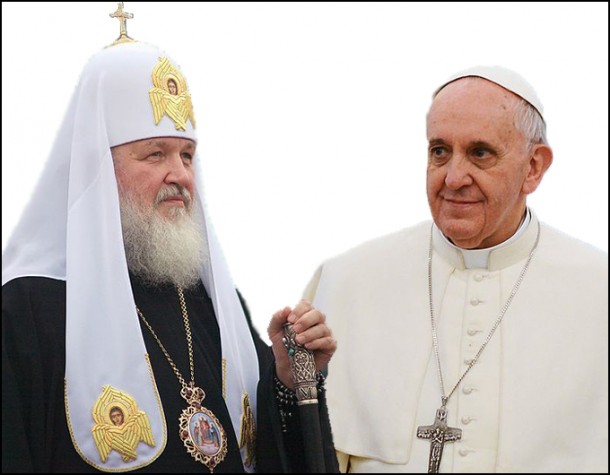 Pope Francis and Russian Orthodox Patriarch Kirill
Pope Francis and Russian Orthodox Patriarch KirillThe issue of encroachment by other Christian denominations into Russia is a particularly sensitive one to many members of the Russian Orthodox Church. They argue that the Orthodox Church now finds itself in a weakened position as a result of decades of secular Communist rule, and is therefore unable to compete on an equal footing with Western Churches. Thus, proselytizing by mostly foreign-based Catholics, Protestant denominations, and by many non-traditional sects can be seen as taking unfair advantage of the still-recovering condition of the Russian Church. On the other hand, many of these groups have argued that the position of Russian Orthodoxy is today no weaker than that of most Western European Churches.[citation needed] Smaller religious movements, particularly Baptists and members of other Protestant denominations, that have become active in Russia in the past decade claim that the state provides unfair support to the Orthodox Church and suppresses others, referring to the 1997 Russian law, under which those religious organizations that could not provide official proof of their existence for the preceding 15 years were seriously restricted in their rights and ability to worship. The law was formally presented as a way to combat destructive cults, but was condemned by representatives of other religions and human rights organizations as being written in a manner that explicitly favored the Russian Orthodox Church, as the Soviet Union had prohibited the establishment of other religions. Consequently, this law gave full rights only to a small number of "first-rank" religions, such as Orthodox Christianity, Islam, Buddhism, and Judaism. The situation is expected to normalise as the 15-year window starts to slide over the post-Communist period.
Due to its deep cultural roots, many members of the Russian government are keen to display their respect for the Church. It is common for the President of Russia to publicly meet with the Patriarch on Church holidays such as Easter (Paskha or Пасха in Russian). Meetings with representatives of Islam and Buddhism occur less frequently.
The Russian Orthodox Church Outside Russia (also known as the Russian Orthodox Church Abroad), based in New York, is a jurisdiction of the church which was separated from Moscow for several decades. The Russian Orthodox Church Abroad was formed in the 1920s by Russian communities outside Communist Russia who refused to recognize the authority of the Russian Orthodox Church, as they believed it had fallen under the influence of the Bolsheviks. Relations between the two churches began improving in the 1990s, and there was a formal reconciliation in 2007 through the Act of Canonical Communion with the Moscow Patriarchate This agreement made the Church Abroad a mostly self-governing branch of the Russian Orthodox Church.
In November 2013 large group of Russian entrepreneurs, public figures and scientists have called for defining a special role of Orthodoxy in the Constitution. The appeal has been submitted to the president, the two houses of the Russian Parliament and Russian regional parliaments. The petitioners say their address was the final document of the conference titled "The Triumph and Collapse of an Empire: Lessons from History". According to them "The state sovereignty of the Russian Federation is law. Our call is for backing up its spiritual sovereignty, too, by declaring the Orthodoxy’s special role in the Russian Constitution".
 Source: Wikipedia
Source: Wikipedia